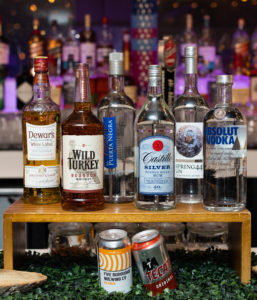written by Marleen St. Marie
NEW YORK, N.Y. – The lobby bar is a great destination spot to easily meet up with friends, family, and coworkers. It can create a favorable first impression of a hotel if it has the right vibe and aesthetics. It also can generate revenue for a hotel if it offers the right drinks and food. But why exactly do you go to the lobby bar?
It’s Convenient
You do not have to leave the hotel property or go far to enjoy a special handcrafted cocktail and delicious snacks.
The Ambiance Speaks to You
Every hotel lobby bar has its own feel to it. Is it a place that is bustling with activity, drawing you into the social hub of the hotel and perfect for casual networking or meeting a friend? Maybe it is quiet and discreet, suggesting a romantic date night or a good fit for a business meeting? Some hotel lobby bars have great artwork and cool designs that set the vibe for the day and evening. The environment works as a great conversation piece as you grab a quick drink before dinner, relax after work, or catch up with friends.
 The Drinks and Food Draw You In
The Drinks and Food Draw You In
Who doesn’t enjoy feeling like a VIP when sipping on a signature-crafted cocktail made “especially for you?” Don’t we all feel good when we support local businesses? We are seeing trends where bars create a “local flavor” by offering a variety of locally sourced craft brews, ciders, seltzers, liquors, and mixers. Not only does this create goodwill in the neighborhood but also it provides out-of-towners with an opportunity to immerse themselves in it. The drink menu can also range from signature-crafted cocktails or creative mocktails and “exclusive to this bar” vintage drinks. The bar food menu, especially during happy hour, can also be a great draw into the lobby bar.
So how do we design a lobby bar that attracts customers and is operationally successful for the hotel?
Programming is Essential
Regardless of the size of the space, you need to understand what you want and need the lobby bar to be and how you can achieve those expectations, as well as any constraints you may have that might require adjustments. Hours of operation, food and drink menu design and development are a big piece of programming as it drives the types of food service equipment required. Perhaps you plan to utilize the lobby bar space in the morning requiring coffee and breakfast to be offered on the menu. If so, espresso machines or coffee brewers and pastry displays are needed.
What about necessary labor requirements for the lobby bar to function efficiently? Maybe self-service options such as self-pour stations, cocktails on tap, and self-ordering tablets will need to be incorporated into the design. Let’s imagine a food menu is offered. Where will the food be cooked? Is there a kitchen down the hall or on another floor? Does the design need to include equipment to hold cooked food or re-heat menu items behind the bar? It’s important to identify and understand the program and function of the space as it relates to the food and beverage operations team.
 Visioning with Architectural Design Team
Visioning with Architectural Design Team
Working closely with the architect and design team is extremely helpful especially when it comes to the vision of the space. You do not want elements of the bar (such as a beer tap color/finish) to clash with the artwork and feel of the bar. Designing a casual sports bar is very different compared to a chic cocktail lounge. That said, it is imperative the foodservice design elements and operational flow are not compromised in the process.
Flexibility is Vital
While some elements are the workhorses of the lobby bar and will always be essential to bar design, others come and go as easily as the trends to which they are bound. It’s important to design the lobby bar to be flexible for current trends as well as future ones. For example, storage space (both back of house and behind the bar) has become a priority in design. Supply chain disruptions as well as rising ingredient costs have made the size of storage space worth a second look. If buying in bulk makes sense to your operation, allocating an ample storage area might be the answer if you have the space for it. Alternatively, if space is at a premium, perhaps you might look at limiting the types of food and drink you offer, thereby decreasing the inventory of ingredients you need to have on hand.
Streamlining the Operation
Understanding the overall floorplan of the hotel and how the lobby bar location relates in the space can also help the food and beverage operation and flow run more smoothly. For example, if food is being offered, is the kitchen close to the lobby bar? If not, support space such as a server’s station to accommodate the food pick-up would be a necessary element to include in the design. A simple, streamlined design incorporating efficiency in operational flow will eliminate added strain on the workforce and reduce operating costs.
The lobby bar has much to offer and can potentially generate a lot of buzz and revenue if the programming and function of the space are clearly defined at the start of a design. There are a lot of details and elements that make a lobby bar a great spot to visit. Every lobby bar is unique to its location…so what brings you to the lobby bar?
Marleen St. Marie is project manager, Cini-Little International, Inc., New York, N.Y.
